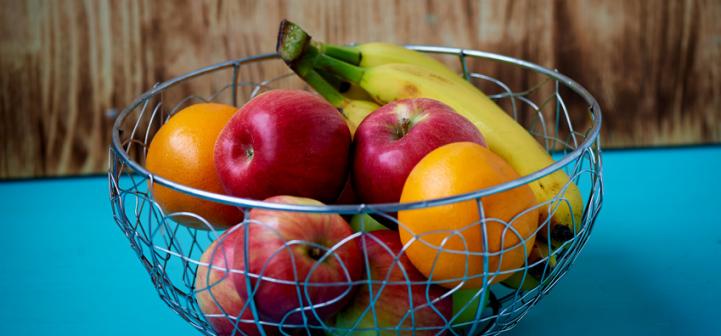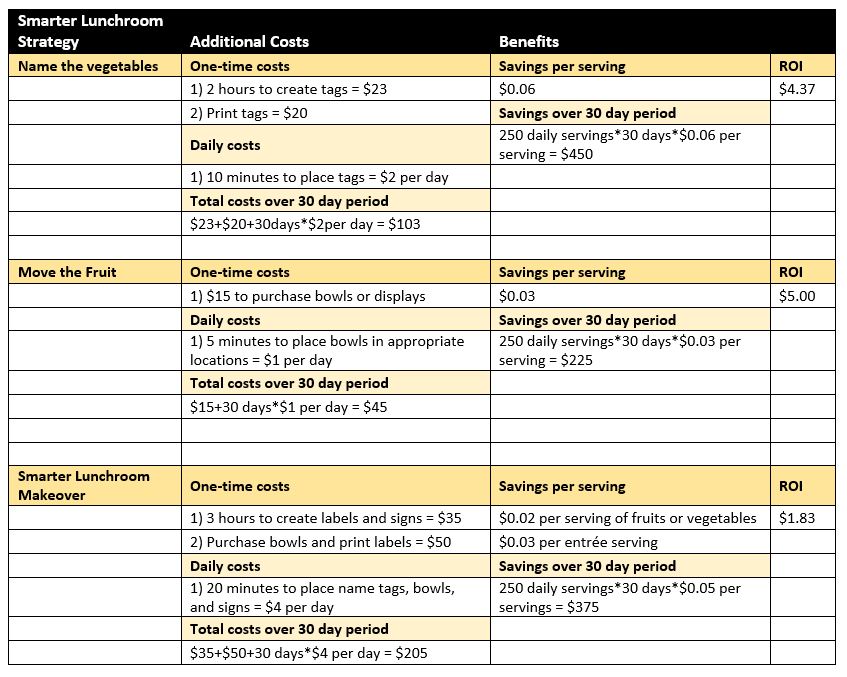
The Smarter Lunchrooms Movement champions several research based behavioral interventions in school cafeterias. The two most widely used interventions are naming the vegetables and moving the fruit. Notably, these interventions are claimed to be cost effective ways for encouraging children to take and consume healthier foods, but is this a valid claim? This article discusses research findings that show how SLM changes actually impact the school meal program bottom line over a standard 6 week intervention period where 250 meals are purchased per long period and cafeteria staff earn the average national minimum wage of $11.47 per hour[1], as provided by the Bureau of Labor Statistics. [2]
Fruits and Vegetables
 Let’s start with fruits and vegetables. A standard serving of fruits or vegetables costs approximately $0.20, on average (this includes fresh, canned, frozen, and dried produce).
Let’s start with fruits and vegetables. A standard serving of fruits or vegetables costs approximately $0.20, on average (this includes fresh, canned, frozen, and dried produce).
1) Name the vegetables: In the Smarter Lunchroom’s standard protocol, it is suggested that age appropriate vegetable names are selected and printed on labels attached to the sneeze shield above the vegetable. For example, elementary school children might respond favorably to X-Ray Vision Carrots whereas older students will be more responsive to names incorporating the school’s mascot, such as Bobcat Salad.
- Labor costs:
- One-time cost of 2 man hours to create tags à cost = $23
- Daily cost of 10 minutes to place tags by the appropriate food à cost = $2 per day
- Other costs:
- One time cost per set of name tags à cost = $20
- Savings:
- $0.06 per serving, based on increased consumption as indicated by research
- Example: If in one day, 250 servings of vegetables are taken, then based on research, the cafeteria saves $15.00 if the staff uses the name tags. This savings is calculated by multiplying 250 servings by $0.06 per serving. Over a 30 day time period, total savings equals $450. Total costs over this time period equal $23 + $20 + ($2*30) = $103
- Return on Investment (ROI): Each dollar invested in the project yields $4.37 in benefits.
- For a 180 day school year, each dollar invested in the project yields $6.05 in benefits.
2) Move the fruit: The SLM standard protocol suggests that cafeteria staff place the fresh fruit next to the register in an attractive bowl or display and in another convenient and well-lit location on the cafeteria line.
- Labor costs:
- Daily cost of 5 minutes to place bowls in appropriate locations à $1.00
- Other costs:
- One-time cost of $10-$15 to purchase bowls or displays
- Savings:
- $0.03 per serving, based on increased consumption as indicated by research.
- Example: In one day the school meal program saves $7.50 for 250 servings of fruit sold when fruit is, placed in a nice bowl and in two locations on the line. This savings is calculated by multiplying 250 servings by $0.03 per serving. Over a 30 day time period, total savings equals $225. Total costs over this time period equal $30+$15 = $45.
- For a 30 day period, each dollar invested in this project yields $5.00 in benefits.
- For a 180 day school year, each dollar invested in this project yields $6.92 in benefits.
3) Smarter Lunchroom Makeover: The Smarter Lunchroom Makeover consists of moving the fruit, naming the vegetables, introducing a convenience line that serves only relatively healthier options (nutrient dense entrée, fruits, vegetables), signs promoting fruits and vegetables, and staff encouraging students to take a fruit or vegetable.
- Labor costs:
- One-time cost of 3 hours to print labels and signs à cost = $35
- Daily cost of 20 minutes to place name tags, bowls, and signs à cost = $4
- Other costs:
- One-time cost of $35-$50 to purchase bowls and print labels and signs
- Savings: ~$0.02 per serving of fruits and vegetables, as indicated in research
- Savings: ~$0.03 per entrée serving as indicated in research.
- Example: If in one day, 250 servings of fruits, vegetables, and an entrée are taken the cafeteria saves $12.50 if the cafeteria makeover has been properly carried out. This savings is calculated by multiplying 250 servings by $0.05 in savings. Over a 30 day time period, total savings equals $375. Total costs over this period equal $35+$50+$120 = $205.
- For a 30 day period, each dollar invested in the project yields $1.83 in benefits.
- For a 180-day school year, each dollar spent on the intervention yields $2.74 in benefits.
While each program and each lunchroom vary slightly in terms of labor, food costs, storage and waste, SLM interventions have a positive return on investment and increase students’ exposure to healthy foods making them more likely to consume them.

Contributor
Drew Hanks, PhD, The Ohio State University
[1] Wage information was accessed at the following website: http://www.bls.gov/oes/current/oes352012.htm#(2).
[2] Benefits such as retirement and health care are not included. But even if a generous 20% benefit rate is included, the cafeteria will still realize a net gain for each intervention.
